Download PDF
Download page Floodway Determination - Example 6.
Floodway Determination - Example 6
This example demonstrates the use of HEC-RAS to perform a floodplain encroachment analysis. Floodplain and floodway evaluations are of substantial interest to planners, land developers, and engineers, and are the basis for floodplain management programs. Most of the studies are conducted under the National Flood Insurance Program and follow the procedures in the "Flood Insurance Study Guidelines and Specifications for Study Contractors," FEMA 37 (Federal Emergency Management Agency, 1985).
FEMA 37 defines a floodway "...as the channel of a river or other watercourse and the adjacent land areas that must be reserved in order to discharge the base flood without cumulatively increasing the water-surface elevation by more than a designated height." Normally, the base flood is the one-percent chance event (100-year recurrence interval), and the designated height is one foot, unless the state has established a more stringent regulation for maximum rise. The floodway is usually determined by an encroachment analysis, using an equal loss of conveyance on opposite sides of the stream. For purposes of floodway analysis, the floodplain fringe removed by the encroachments is assumed to be completely blocked.
For this example, the floodplain encroachment analysis was performed to determine the maximum encroachment possible, constrained by a 1 foot maximum increase in water surface elevation from the natural profile. The geometric data used in this example are identical to the cross-section and bridge geometric data used in Example 2.
To review the data files for the current example, from the main HEC-RAS window, select File and then Open Project. Go to the directory in which you have installed the HEC-RAS example data sets. From the "Applications Guide\Example 6 – Floodway Determination" subdirectory, select the project labeled "Floodway Determination - Example 6." This will open the project and activate the following files:
Plan: "Method 5 Encroachment"
Geometry:"Existing Conditions"
Flow: "Base + 1 ft Target Depth"
 Example 6 - Floodway Determination.zip
Example 6 - Floodway Determination.zip
Floodplain Encroachment Analysis Procedure
Currently, the HEC-RAS program has 5 methods to determine floodplain encroachments. These methods are:
- Method 1 -User enters right and left encroachment stations
- Method 2 -User enters fixed top width
- Method 3 -User specifies the percent reduction in conveyance
- Method 4 -User specifies a target water surface increase
- Method 5 -User specifies a target water surface increase and maximum change in energy
For a detailed discussion on each of these methods, the user is referred to Chapter 9 of the Hydraulic Reference Manual.
The goal of performing a floodplain encroachment analysis is to determine the limits of encroachment that will cause a specified change in water surface elevation. To determine the change in water surface elevation, the program must first determine a natural profile with no encroachments. This base profile is typically computed using the one percent chance discharge. The computed profile will define the floodplain, as shown in the figure below.
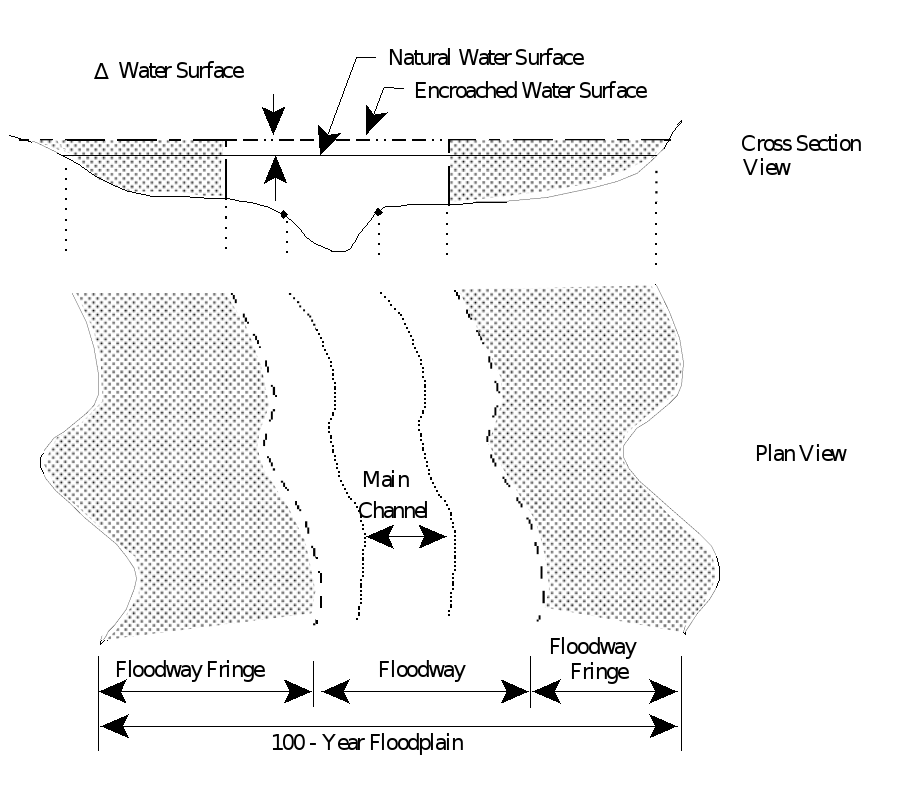
Then, by using one of the 5 encroachment methods, the floodplain will be divided intotwo zones: the floodway fringe and the floodway. The floodway fringe is the area blocked by the encroachment. The floodway is the remaining portion of the floodplain in which the one-percent chance event must flow without raising the water surface more than the target amount.
For this example, the following procedure was employed to perform the encroachment analysis:
- Determine the 100-year flood profile
- Method 5 optimization procedure
- Method 4 - with 3 target depths
- Method 4 - with 1 target depth
- Method 1 - final delineation of floodway
- Review of floodway delineation sketch
To perform the floodplain encroachment analysis for this example, the first step was to develop a model of the river reach that would compute the 100-year flood profile. This model must be developed and calibrated to the fullest extent possible because it defines the base flood elevations and all subsequent calculations will be based upon this profile. This was accomplished in Example 2.
After the base profile was computed, the Method 5 procedure was chosen as an initial attempt to calculate the encroachments. Method 5 will typically calculate reasonable encroachment stations for "well behaved" streams. That is, for streams that exhibit minor changes in cross section geometry and have small losses due to bridges and culverts. If the river reach has abrupt changes in geometry or orientation, contains a flow controlling structure, or the encroachments encounter the main channel bank stations, then Method 5 may produce erratic results at these locations.
If Method 5 produces inconsistent results, then Method 4 may be utilized. Method 4 is frequently used for a floodplain encroachment analysis. The initial approach is to use this method with several target water surface increases.
Finally, after the results are obtained from the Method 4 analysis, Method 1 was used to further refine the encroachment stations. The modeler should sketch the floodway on a topographic map to visually inspect the floodway and allow for smooth transitions. The computed floodway is considered preliminary, in that the regulating community must approve and adopt.
Each of these steps, as performed for this example, are discussed in detail in the following sections.
Base Flood Profile
To perform the floodway analysis, the user must first determine the natural (existing conditions) 100-year flood water surface profile for the river reach. Therefore, a model of the existing river system must first be developed and calibrated to the fullest extent possible.
For this current example, the river reach and bridge geometric data of Example 2 were used. During Example 2, the HEC-RAS program was used to develop a calibrated model of the "Kentwood" Reach of Beaver Creek for a flow of 14000 cfs. During the analysis of that flood event, it was determined that the pressure/weir method produced water surface values that were comparable to the observed data. Verification that the model is adequately modeling the river system is an important step before starting the floodway analysis. For this example, the pressure/weir geometry file from Example 2 was used. This file was renamed to be "Existing Conditions" and was used for all of the plans developed here.
Method 5 Optimization Procedure
In general, when performing a floodway analysis, encroachment Methods 4 and 5 are normally used to get a first cut at the floodway. For this example, Method 5 was used as an initial attempt to determine the encroachment stations. Encroachment Method 5 is an optimization scheme that will use a target increase in the water surface elevation and/or a maximum limit for the increase in energy to obtain the encroachment stations. The program will attempt to meet the target water surface while maintaining an increase in energy that is less than the maximum.
Method 5 Steady Flow Data
To perform the Method 5 encroachment analysis, the flow data were first entered. From the main program window, select Edit and then Steady Flow Data. This activated the Steady Flow Data Editor. For the Method 5 analysis, 2 water surface profiles were chosen to be calculated. The first profile was used to determine the base profile and the second profile was used to determine the encroached profile. The flow values for both of the profiles were entered as 14000 cfs, the flow value that the model was calibrated. Then, the Boundary Conditions icon was selected and the Downstream Known Water Surface elevations were entered as 211.8 and 212.8. The first downstream boundary condition (211.8) was determined during Example 2. The second downstream boundary condition (212.8) was set at 1 foot higher to coincide with the maximum possible change in downstream water surface elevation. This accounted for the possibility of future encroachments downstream of the modeled reach. Finally, the steady flow data was saved as "Base + 1 ft Target Depth."
Method 5 Encroachment Data
To enter the data for encroachment Method 5, from the main program window select Run, Steady Flow Analysis, Options, and then Encroachments. This will activate the Encroachments Data Editor as shown in the figure below. The editor and the entering of data is divided into the following sections: global information; reach and river station information; and method and target values. The following sections describe each of the data entry items. For a further discussion of the data entry procedure, the user is referred to Chapter 9 of the User's Manual.
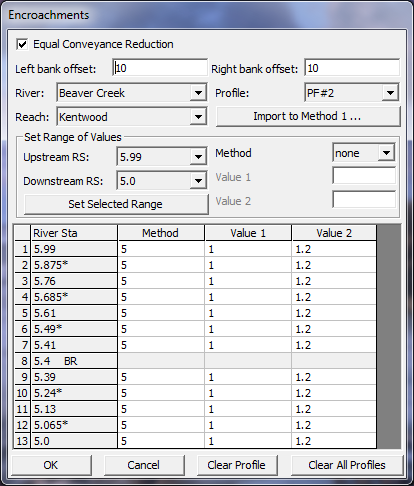
The global information is applied to all of the reaches and cross sections that will be selected for the analysis. The first input for the global information is the Equal Conveyance Reduction box. If this box is selected, then the program will encroach by simultaneously removing an equal amount of conveyance on both sides of the main channel. As the amount of conveyance is removed, if one of the encroachments reaches the main channel bank station (or the offset), then the program will continue to encroach on the other side until the target values are obtained or until the encroachment on the other side reaches the main channel bank station (or the offset). If the equal conveyance box is not selected, then the program will encroach by maintaining a loss of conveyance in proportion to the distribution of the natural overbank conveyance. The equal conveyance reduction applies to Methods 3, 4, and 5; and, for this example, the option was selected.
The next global information items are the Left bank offset and the Right bank offset. These offsets limit the distance of the encroachments. Without an offset, encroachments can go up to the bank stations, eliminating the entire overbank. For this example, the offsets were set to be 10 feet for both the left and right bank. Therefore, the limit of encroachment was 10 feet to the left of the left channel bank station and 10 feet to the right of the right channel bank station.
Reach and River Station Information. The next items to select in the encroachments editor are the River and Reach that will be analyzed. For this example, there is only one river and reach: the "Kentwood" reach on the river "Beaver Creek." Next, the Starting River Station and Ending River Station were entered. The analysis was set to begin at river station 5.99 and end at river station 5.00, the entire river reach. Finally, the Profile was selected. For a Method 5 analysis, only 2 profiles are necessary. The first profile will be used to determine the base water surface profile and cannot be selected in the encroachments data editor. The second profile is selected to be used for the Method 5 analysis.
Method and Target Values. Method 5 was selected for this analysis. When a method is selected, the data entry fields required for that method will appear immediately under the method field. For Method 5, the fields Target WS change (ft) and Target EG change (ft) appeared. A target water surface change of 1.0 foot and a target energy change of 1.2 feet were entered. Typically, the energy target will be chosen to be slightly greater than the water surface target. The energy target will act as an upper limit during the iterations to prevent the encroachment from getting very large. The next step is to select the range of the river reach that will be analyzed, for the target values that were entered. For this example, the Set Selected Range button was selected and this applied Method 5 and the chosen targets to the selected range of river stations 5.99 to 5.00 for the Beaver Creek reach. By selecting this button, the fields in the table were filled with the corresponding method and values. In the table, since Method 5 was selected, the heading Value 1 corresponds to the target water surface change and Value 2 corresponds to the target energy change. When other methods are selected, the value 1 and value 2 columns will represent the specific data input items for the method. (Note: Some methods only require 1 value.) As a final note, the user can now edit the data table and change any of the methods and value items for any specific river station. For this example, the table was not edited at this time.
The OK button was then selected at the bottom of the encroachment editor. This prompted the Steady Flow Analysis Window to appear. Then the geometry file "Existing Conditions" and the steady flow file "Base + 1 ft Target Depth" were saved as the plan "Method 5 Encroachment." Finally, the Short ID was entered as "M5" and the COMPUTE button was selected for the subcritical flow analysis.
Method 5 Output Review
The output of the encroachment analysis can be viewed both graphically and in tabular format. For this analysis, the encroachment data tables were reviewed. From the main program window, select View, Profile Summary Table, and then Std. Tables. The program generates 3 encroachment tables, with each table providing some of the same information and additional data. For this analysis, select Encroachment 1. A portion of this table is shown in the figure below. The figure displays the bottom portion of the table.
The table is divided into sets of rows, with each set containing two rows. The first row in each set is for the un-encroached profile and the second row is for the encroached profile. Columns one and two show the reach and river stations and the third column shows the calculated water surface elevation. The fourth column shows the difference between the first profile and each of the encroached profiles. Starting at river station 5.00 (at the bottom of the table), the difference in the water surface elevations for the encroached profile is 1 foot because the downstream boundary condition set the elevation change of 1 foot.
Review of the method 5 results shows that the method provided reasonable results up to the bridge to river station 5.39. However, at the bridge the method produced a negative surcharge. Further upstream, the encroachment method produced results up to the 1.0 foot allowable rise. This method had difficulty determining the encroachments around the bridge because the bridge hydraulics performed like a local control. This will be discussed further in the Method 4 analysis.
From the analysis of the Method 5 output, it was determined that the results were not acceptable upstream of the bridge and an alternate procedure should be then undertaken. The results from Method 5 up to the bridge could be used as a starting point for future analysis with a different method.
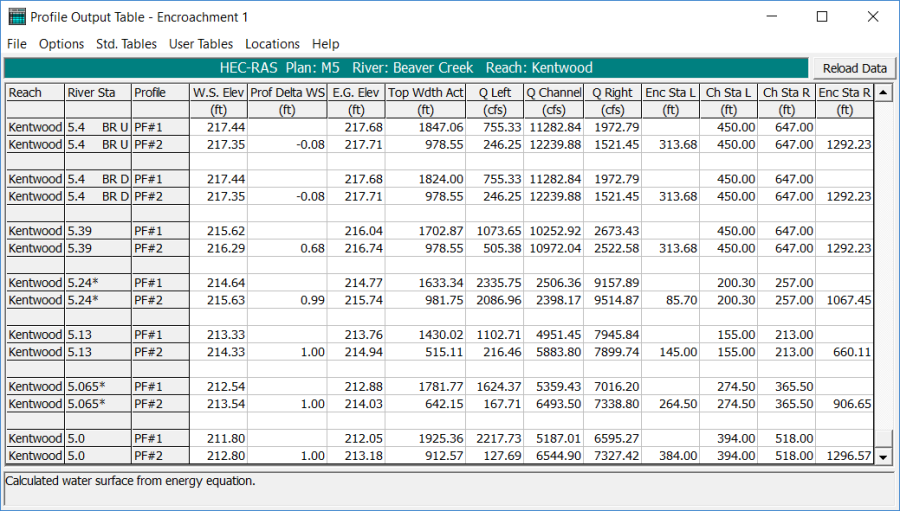
Method 4 Encroachment Analysis - Trial 1
An alternative approach to perform the encroachment analysis is to use Method 4. The Method 4 analysis is similar to Method 5, without the iterative solution technique. To perform the Method 4 analysis, the program uses the following procedure:
- First, the program computes the base water surface profile by using the data from the first profile in the steady flow data editor. With this profile, the program calculates (among other parameters) the water surface profile and the conveyance for each river station.
- For the second profile, starting at the first river station, the program takes the user supplied target water surface increase and adds this value to the base water surface elevation. With the increased water surface elevation, the program calculates the new conveyance at this river station. (Note: The first river station is located at the downstream end of the river system for a subcritical flow analysis.)
- The program then determines the increase in conveyance between the base profile and the increased water surface profile. One half of this increase in conveyance will be removed from each side of the cross section fringe, if the equal conveyance option was selected. If the equal conveyance option was not selected, then the program will remove the conveyance from both sides in proportion to the natural conveyance. In either case, the difference of conveyance will be removed from the cross section, if possible.
- To remove the conveyance, the program starts at the limits of the increased water surface profile and encroaches on both sides towards the main channel. As the conveyance is removed from both sides, the program checks to determine if the encroachment has reached the main channel bank station (or the offset) on that side. If the main channel bank station (or offset) is encountered, then the program will stop encroaching on that side and will make up the difference on the other side. If the encroachment on the other side encounters the main channel bank station (or offset), then the program can no longer continue to encroach.
- Once the increase in conveyance has been removed from the cross section, with the higher water surface elevation, the encroachment stations are set. Also, the conveyance at the cross section with the higher water surface is now the same as the original conveyance at the cross section (if possible). Then the program uses the new geometry of the encroached cross section to determine the depth of flow at that cross section. Since the geometry of this river station has changed, the value of the friction slope and velocity head will change. Also, the magnitude of the expansion or contraction losses will change. Therefore, when the program calculates the water surface elevation with the new geometry, the depth of flow will typically be different than the target value entered by the user. In other words, even though the total conveyance is the same at this river station, the geometry, friction slope, and energy losses are different and this will produce a different flow depth at this river station. Often, the resulting depth of flow will be greater than the target increase in water surface elevation. Therefore, the first run with Method 4 is typically applied with several target values, usually smaller than the maximum increase.
- The program then moves to the next river station and steps 2 through 5 are repeated. This process continues until the last river station is evaluated.
Method 4 Steady Flow Data - Trial 1
To perform the Method 4 encroachment analysis, the flow data was first entered. The Steady Flow Data Editor was activated and 4 water surface profiles were chosen to be calculated. The first profile is still the base profile. The second, third and fourth profiles were used to determine the encroached profiles with different target depths. The flow values for all of the profiles were entered as 14000 cfs, the 1 percent chance flood event. Then, the Boundary Conditions icon was selected and the Downstream Known Water Surface elevations were entered as 211.8, 212.8, 212.8, and 212.8. The first downstream boundary condition (211.8) was determined during Example 2. The other downstream boundary conditions (212.8) were set 1 foot higher to coincide with the maximum possible change in downstream water surface elevation. This accounted for the possibility of future encroachments downstream of the modeled reach. Finally, the steady flow data was saved as "Base + 3 Target Depths."
Method 4 Encroachment Data - Trial 1
The Method 4 encroachment data were then entered, similar to that for Method 5. First, the Encroachment Data Editor was selected from the Options menu of the Steady Flow Analysis window. The encroachment editor is shown in the first figure on this page. Then, the global information of equal conveyance reduction and a 10 foot left and right offset were selected. The reach was selected as "Kentwood" and the starting and ending river stations were set as 5.99 and 5.00, respectively. Next, profile 2 and Method 4 were selected. Since Method 4 was chosen, this caused the data entry box Target WS change (ft) to appear. A target value of 0.8 feet was then entered and the Set Selected Range button was chosen. This filled in the table with the Method 4 and 0.8 foot change in water surface for the entire reach. Finally, the target value for river station 5.00 was changed to 1.0 foot. This will assume that the encroachment matched the target water surface of the downstream boundary condition. If the modeler is aware of the actual water surface increase at this river station (from other encroachment analyses), then this value should be used. Typically, this information is not known and therefore the modeler should include river stations below the area of interest so that the boundary conditions do not effect the region of the study.
Next, Profile 3 was selected by depressing the down arrow adjacent to the profile field. Then Method 4 was chosen and a Target WS change (ft) of 0.9 feet was entered. The Set Selected Range button was selected and this filled in the table with Method 4 and target values of 0.9 feet for the selected range. Then, the target value at river station 5.00 was changed to 1.0 foot, as performed previously. This procedure was repeated once more with the fourth profile for Method 4 and a target water surface change of 1.0 foot. The user should note that this method only requires one data input item and, therefore, the data will appear under "Value 1" of the table. The OK button was then selected to close the encroachment editor.
Finally, the geometry file "Existing Conditions" and the steady flow data file "Base + 3 Target Depths" were saved as a plan entitled "Method 4 Encroachment - Trial 1." The Short ID in the Steady Flow Analysis Window was entered as "M4 - Trial 1." This identification will assist the user when analyzing the output. Then, the COMPUTE button was selected to perform the calculations.
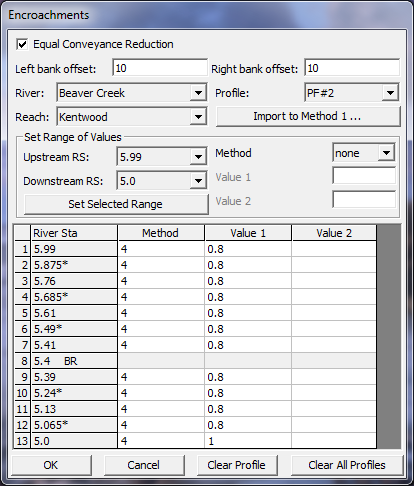
Method 4 Output - Trial 1
To review the output, the Encroachment 1 table was selected and a portion of this table is shown in the below. For each river station, there are four rows of data in the table. The first row is for the natural, un-encroached profile. The second, third, and fourth rows are for the second, third, and fourth profiles. These profiles were set with target values of 0.8, 0.9, and 1.0 foot, respectively (except for the first river station which had a constant target of 1.0 foot). The first non-fixed column of the table shows the water surface elevation for each profile. The second column displays the change in water surface from the natural profile for the encroached river station. Additional column headings show the calculated value of the energy gradeline, flow, calculated encroachment stations (by toggling to the right in the table), etc. Depending upon the required information, the user can select one of three encroachment tables. Further discussion of the encroachment tables is presented in Chapter 9 of the User's Manual.
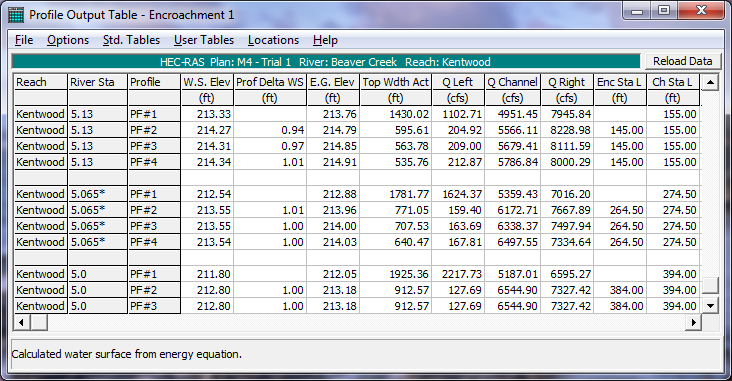
For this review of the first run of Method 4, the main concern is with the change in water surface elevation. The encroachment process and resulting water surface elevations were determined using the 6 steps as described previously at the beginning of this section. For river station 5.00, the change in water surface was 1.0 foot for all of the target values because the downstream boundary conditions were set to be 1 foot higher than the base profile. At river station 5.13, the changes in water surface were 0.94, 0.97, and 1.01 feet for the target values of 0.8, 0.9, and 1.0 feet. This shows that the actual resulting water surface is generally greater than the target values. Further review of the table shows the various resulting water surface elevations for the target depths.
To continue the encroachment analysis process, a Method 4 analysis was again calculated, however this was performed with only 1 target depth for each river station. The target depths that were used in the subsequent analysis were the target depths that resulted in a water surface change as close to 1 foot without exceeding 1 foot. For example, at river station 5.13, the resulting change in water surface that is as close to 1 foot as possible without exceeding 1 foot is 0.97 feet. This value was obtained from a target increase of 0.9 feet from the third profile. Therefore, for the next trial, a target value of 0.9 was used at river station 5.13. Likewise, a target of 0.80 was used at river station 5.24* because this target yielded a change in water surface of 0.94 feet. The following table shows the values that were used for the subsequent analysis.
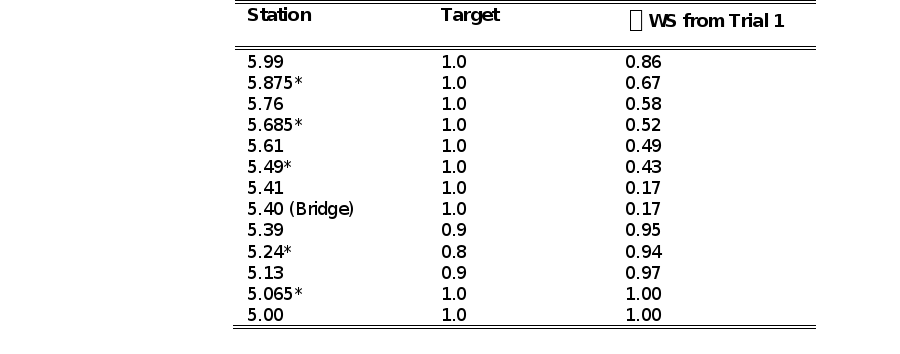
It should be noted that for the bridge river station (5.40), the user can only enter one target value into the encroachment data editor. Therefore, only one target value appears in the table above. Additionally, since the pressure/weir option is being used as the high flow analysis method, the program will use the encroachments calculated at river station 5.39 as the encroachments for river stations 5.40 and 5.41. This will be discussed further in the proceeding section and additional discussion is provided in Chapter 9 of the Hydraulic Reference Manual.
Method 4 Encroachment Analysis - Trial 2
The next step to define the encroachments was to again use a Method 4 analysis, but with only 1 target depth for each river station. To perform the analysis, a steady flow data file was first developed and then the encroachment data were entered. Finally, this section will review the output from the second run using the Method 4 analysis.
Method 4 Steady Flow Data - Trial 2
Since this analysis only requires two profiles, the steady flow data file as developed for the Method 5 analysis was used. This file, "Base + 1 ft Target Depth," included only 2 profiles (14000 cfs each) and had the downstream known water surface boundary conditions set at 211.8 and 212.8 feet.
Method 4 Encroachment Data - Trial 2
To enter the data for the second Method 4 analysis, the Encroachment Data Editor was activated from the Steady Flow Analysis Window. This encroachment editor is shown in the figure below. As entered previously, the equal conveyance option was selected and a left and right offset of 10 feet were entered. The reach of "Kentwood" was selected (the only reach in this example) and the starting and ending river stations were 5.99 and 5.00, respectively, which included the entire river reach. Then the profile was selected as 2 (since the first profile is used to calculate the base profile).
For this analysis, Method 4 was selected for each river station and the target water surface values for each river station were obtained from the table in Trial 1, as discussed previously. At this point, the user can enter the data directly into the table. A 4 was placed adjacent to each river station under the "Method" column and the target values for each river station were entered directly into the table under "Value 1," a portion of which is shown in the figure below. (The remaining values can be observed by using the toggle arrows on the right side of the editor.) Finally, the OK button was selected to exit the data editor.
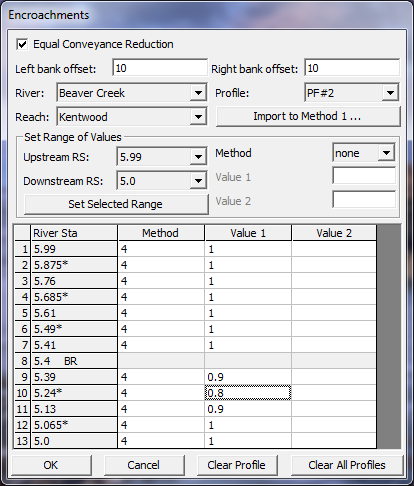
A new plan was created with the geometry data file "Existing Conditions" and the steady flow data file "Base + 1 ft Target Depth." These files were saved as the plan "Method 4 Encroachment - Trial 2." The Short ID was entered as "M4 - Trial 2" and the COMPUTE button was then selected.
Method 4 Output - Trial 2
The output from the encroachment analysis can be viewed in either tabular or graphical form. For a tabular review, the user can select from 1 of 3 tables defined by the program (or the user can create a table). For this review, a portion of the Encroachment 1 Table is shown in the figure below. (Note: The flow columns have been removed from the table in the text.)
As described previously, the first non-fixed column is the resulting water surface elevation and the second column is the difference in the water surface profile from the first profile. The goal of this analysis is to determine the encroachments so that the resulting water surface does not change by more than 1 foot. As can be seen by the results in the table, the change of water surface for river stations 5.00 and 5.065* are both 1.00 feet. For river station 5.13, the change in water surface is 1.01 feet. This value was obtained with a target value of 0.9 feet. Therefore, to decrease the resulting water surface elevations at this river station, the target value for this river station must be decreased and a subsequent Method 4 analysis performed. This iterative process of changing the target values and reviewing the output can determine the floodway that will result in a change of water surface less than 1 foot.
When performing a subcritical flow analysis, the user should begin this iterative process at the downstream cross section and work upstream. Additionally, the user should not attempt to adjust a large quantity of target values at the same time. For this example, the target values for the river stations below the bridge (5.00 through 5.29) were adjusted first. Then the bridge section was analyzed and finally the upstream river stations were adjusted. This procedure will allow the user to focus on specific river sections and adjust these target values before moving onto the further upstream river stations.
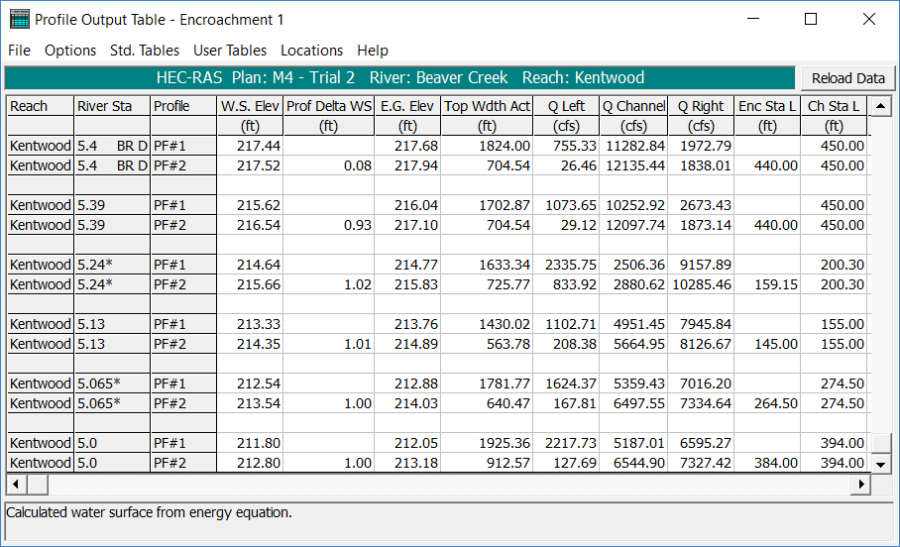
As an additional review of the encroachment 1 table, it can be seen that the left and right encroachment stations that were calculated for river station 5.39 were 440.00 and 1144.54. These encroachments were then used for river stations 5.40 and 5.41. This is a default method for the program since the pressure/weir method was used for the bridge high flow analysis. If the energy method had been used, then the program would allow for separate encroachment stations throughout the bridge.
Finally, the left encroachment station of 440 at river station 5.39 is 10 feet to the left of the main channel bank station. Therefore, the program encroached up to the left offset on this side of the main channel. (This also occurred at river stations 5.00, 5.065*, and 5.13.) If the offsets had not been used, then the left encroachment would have continued up to the main channel bank station. When this occurs, additional wetted perimeter will be added to the main channel. This will cause the conveyance of the main channel to decrease and the total loss of conveyance at the cross section may be greater than if the encroachment did not encounter the main channel. Therefore, this may reduce the amount of encroachment on the right side of the channel since an additional loss of conveyance had already occurred.
To determine the percent reduction of conveyance removed from each side, the Encroachment Table 2 can be viewed. A portion of this table is shown as the following figure. From the table, it can be seen that for river station 5.00, an approximately equal amount of conveyance was removed from each side of the main channel (15.43 and 15.53 percent for the left and right sides, respectively). This occurred even though the encroachment encountered the left offset. However, for river station 5.065*, the encroachment also encountered the left offset but the percent reduction of left and right conveyance is not equal. The percent of conveyance removed at river station 5.065* is 10.79 and 18.89 for the left and right sides, respectively. This implies that after the left encroachment reached the left offset, the program needed to remove an additional amount of conveyance from the left. Therefore, the program removed that amount from the right side in addition to the amount required to be removed from the right side. This caused the percent of conveyance removed to be unequal on both sides of the main channel.
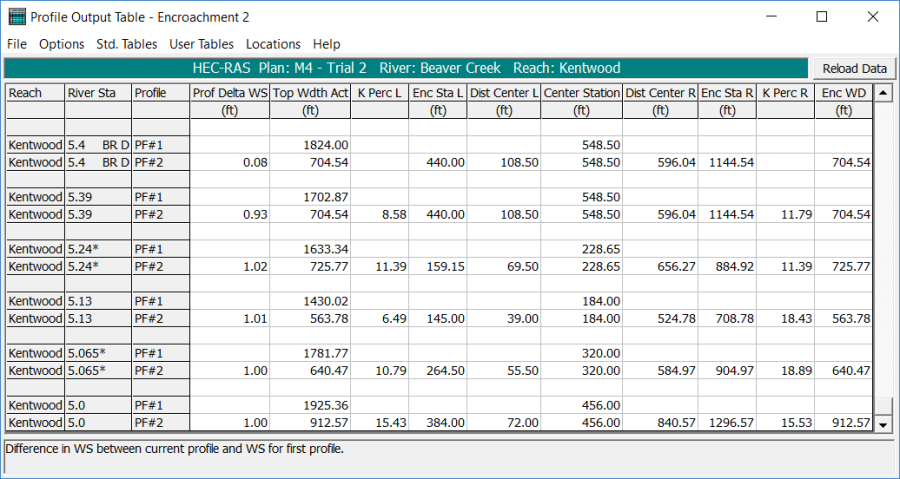
Method 4 Encroachment Analysis - Trial 3
To further define the encroachments, an iterative process was performed by changing the target values at the river stations and then executing the Method 4 analysis. Before the iterative process was started, the data was saved as a plan entitled "Method 4 Encroachment - Trial 3." Then, as mentioned previously, the iterations were performed first for the river stations below the bridge (5.00 through 5.29), then the bridge vicinity was analyzed (5.39, 5.40, and 5.41), and finally the upstream river sections were evaluated (5.49* through 5.99). The target values and resulting rise in water surface which yielded the most practical results are shown in the following table:
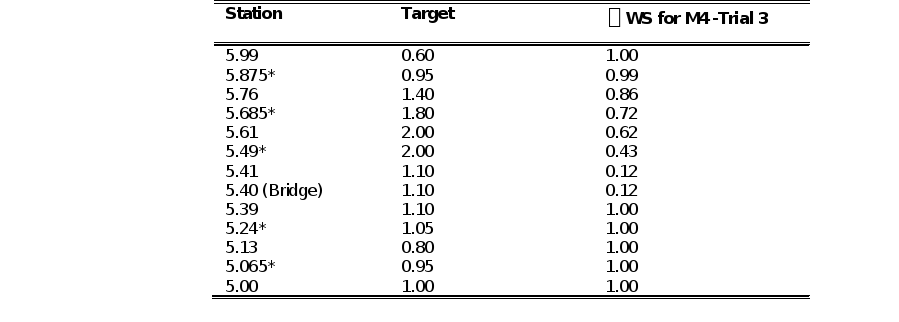
The final target water surface values used and the resulting change in water surface are listed in the table above. These values were obtained from the Encroachment Table in trial 1 as discussed previously.
In the vicinity of the bridge, a target value of 1.1 foot at river station 5.39 (just downstream of the bridge) was found to result in the most practical encroachments through the bridge. If a higher target value was used, the program would encroach further towards the main channel and a slightly higher water surface value would be obtained at river stations 5.39, 5.40, and 5.41. If the encroachments at the bridge were moved closer to the main channel, then this would further increase the upstream water surface. The increase in upstream water surface is in effect before the upstream encroachments are calculated. Therefore, the upstream encroachments are limited from the start because the upstream water surface elevation is already greater than the natural profile.
As the target value at river station 5.39 was increased beyond 1.1, the program could only provide minor encroachment distances at river station 5.49*. This created an erratic transition in the floodway at river station 5.49*. As a compensation between the bridge encroachment constriction and initial upstream rise, the target value of 1.1 foot at river station 5.39 was determined to be most practical.
Additionally, at river station 5.40 (the bridge) and 5.41, the change in water surface was only 0.11 feet. This water surface elevation only increased slightly due to two factors. First, the rise in water surface upstream of the bridge (river station 5.41) is controlled by the bridge structure itself, due to the occurrence of pressure and weir flow. The increase in water surface at section 5.39 did not cause enough submergence on the weir to increase the upstream headwater. Secondly, the conveyance reduction at 5.40 and 5.41 removed only the weir flow that was occurring. This reduction of weir flow was not sufficient enough to cause the water surface to rise dramatically. This implies that the pressure flow was dominate through the bridge opening. The modeler should check the bridge solution to determine the value of the pressure flow. For this example, the pressure flow through the bridge was 12179.63 cfs, a major portion of the total flow of 14000 cfs.
It should be emphasized that the Method 4 iterations were continued until a practical floodway was developed. After the Method 4 procedure was completed, the results were used in a Method 1 analysis which is discussed in the following section.
Method 1 Encroachment Analysis
Typically, the floodplain encroachment method results are converted to Method 1 to perform minor adjustments for smoothing the floodplain. To perform a Method 1 analysis, the user must enter the left and right encroachment stations for each cross section. For this example, the encroachment stations as determined by the Method 4 iterative procedure were used for the Method 1 analysis. To perform the analysis, first the steady flow data was entered and then the encroachment data was entered. Finally, this section will discuss the output from the Method 1 analysis.
Method 1 Steady Flow Data
For the Method 1 analysis, only 2 flow profiles were used. Therefore, the steady flow data file "Base + 1 ft Target Depth" was used for this analysis. This was the same file as used for the Method 5, the Method 4 - Trial 2, and the Method 4 - Trial 3 plans.
Method 1 Encroachment Data
To enter the encroachment data, the Encroachment Data Editor was activated from the Steady Flow Analysis window. The encroachment editor was opened from the plan that contained the final Method 4 iterative results. Then, the Import to Method 1 icon was selected. This option prompts the program to read the final encroachment results from the currently opened plan, and to automatically convert those output results to encroachment Method 1 input. Once the data appeared in the table, the OK button was selected. Then the geometric file "Existing Conditions" and the steady flow data file "Base + 1ft Target Depth" were saved as the plan "Method 1 Encroachment." The Short ID was entered as "M1" and the COMPUTE button was selected.
Method 1 Output
The output from the Method 1 analysis should be identical to the output from the Method 4 iterative plan output. This was verified by comparing the resulting changes in water surface elevation at the river stations. At this point, the user can fine tune and adjust the encroachments as deemed necessary by adjusting the left and right encroachment stations in the Encroachment Data Editor. For this example, no further adjustments were made.
To review the output in graphical form, from the main program window select View and then X-Y-Z Perspective Plots. This will result in the display as shown in the following figure. As can be seen below, the encroachment stations appear to follow a smooth transition throughout the river reach. However, the user must be aware of the fact that this plot is based upon the X-coordinates as entered by the user. If the X-coordinates for the cross sections are not all established from the same left baseline, then the plot may not be accurately portraying the correct configuration of the floodway. The modeler should sketch the resulting encroachments and floodway on a topographic map to view the correct alignment of the floodway. At this point, further refinement for the locations of the encroachments stations should be made.
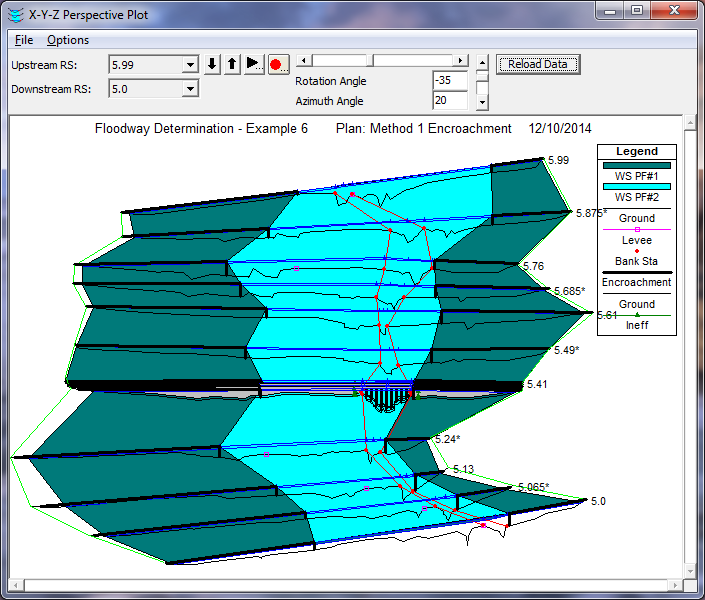
In addition to the 3-D plot, the user can also view the individual cross section plots to see the location of the encroachment stations. By using the information from the encroachment tables, the cross section plots, the 3D plot, and the user developed topographic plot, the encroachment stations should be evaluated for the required constraints and the transitions of the floodway.
Summary
To perform the floodway analysis for this example, a Method 5 procedure was first attempted. This procedure can yield reasonable results for a smooth transitioning river reach. However, for this example, the bridge structure in the river reach caused difficulties in the Method 5 analysis and the program did not yield reliable results upstream of the bridge.
To continue the analysis, a Method 4 procedure was employed. First, 3 target depths were used to obtain a first cut at the encroachment stations. Then, the Method 4 procedure was employed iteratively with one target value for each river station to further define the encroachments. After the encroachments appeared to be well established, the results were imported to Method 1 for a final check on the encroachments and to perform any additional smoothing of the floodway transitions.
When performing a floodway analysis, the general approach is to attempt to encroach on both sides of the water course without increasing the water surface elevation by some predefined amount. The user should also be aware of other constraints such as velocity limits and equal conveyance reduction requirements, which may be constraining the floodway delineation. Additionally, the floodway must be consistent with local development plans and provide reasonable hydraulic transitions throughout the study reach. These transitions must be determined by plotting the encroachment stations onto a topographic map. The user should not rely on the 3-D plot provided with the program due to the constraints of the plot as described previously.